Why Reproduction Matters More Than You Think
Have you ever wondered why you have your mother’s eyes but your father’s smile? Or why identical twins look exactly the same while regular siblings don’t? Or even why farmers can grow an entire field of genetically identical bananas? The answer lies in reproduction – one of the most fascinating and essential topics in biology.
Reproduction isn’t just about “making babies” (though that’s certainly part of it!). It’s the fundamental process that ensures life continues on Earth, explains why you’re unique, and even helps scientists develop disease-resistant crops to feed the world. Whether it’s bacteria dividing in your gut, flowers blooming in spring, or the miracle of human development, reproduction is happening all around us, every single day.
In this comprehensive guide, we’ll explore everything you need to know about Topic 16 for your IGCSE Biology 0610 exam. We’ll break down complex concepts into bite-sized pieces, use plenty of real-world examples, and give you the tools to ace those exam questions. Let’s dive in!
What is Reproduction? Understanding the Basics
Reproduction is the biological process by which living organisms produce new individuals of their own kind. It’s one of the seven characteristics of living things and absolutely essential for the survival of species.
Think of reproduction as nature’s way of ensuring that life doesn’t just end with one generation. Without it, humans, animals, plants, and even microorganisms would simply die out, and life on Earth would cease to exist.
There are two main types of reproduction you need to understand:
1. Asexual Reproduction
2. Sexual Reproduction
Let’s explore each one in detail.
Asexual Reproduction: One Parent, Identical Offspring
What is Asexual Reproduction?
Asexual reproduction involves only one parent and produces offspring that are genetically identical to the parent. These identical offspring are called clones.
Key Features:
- No fusion of gametes (sex cells)
- No variation in offspring (except random mutations)
- Faster than sexual reproduction
- Doesn’t require a mate
- Common in plants, fungi, bacteria, and some simple animals
Types of Asexual Reproduction
1. Binary Fission
This is how bacteria and some single-celled organisms reproduce. The parent cell simply divides into two identical daughter cells.
Real-life example: The bacteria in yogurt reproduce through binary fission, which is why they can multiply so quickly and ferment milk overnight!
2. Budding
A small outgrowth (bud) develops on the parent organism, grows, and eventually detaches to become an independent organism.
Real-life example: Yeast cells reproduce through budding – this is crucial for bread-making and brewing beer!
3. Spore Formation
Organisms produce specialized cells called spores that can develop into new individuals under favorable conditions.
Real-life example: Fungi like mushrooms release millions of spores into the air that can grow into new fungi.
4. Vegetative Propagation (in Plants)
New plants grow from parts of the parent plant such as stems, roots, or leaves.
Real-life example: When you cut a piece of a spider plant and place it in water, it grows roots and becomes a new plant!
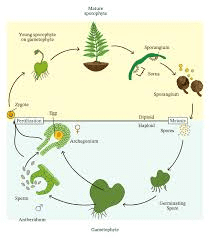
Advantages of Asexual Reproduction
✓ Speed: Produces offspring quickly
✓ Efficiency: Only one parent needed
✓ Energy-saving: No need to find a mate
✓ Favorable traits preserved: If the parent is well-adapted, so will be the offspring
✓ Large numbers: Can produce many offspring rapidly
Disadvantages of Asexual Reproduction
No genetic variation: All offspring are clones
Vulnerability to disease: If one is susceptible, all are susceptible
Lack of adaptability: Can’t adapt quickly to environmental changes
Accumulation of mutations: Harmful mutations pass to all offspring
Sexual Reproduction: Two Parents, Unique Offspring
What is Sexual Reproduction?
Sexual reproduction involves two parents (usually male and female) and produces offspring that are genetically different from both parents and from each other.
Key Features:
- Involves fusion of gametes (sex cells)
- Creates genetic variation
- Slower than asexual reproduction
- Requires finding a mate
- Common in most animals and many plants
The Process: Gametes and Fertilization
Gametes are specialized sex cells:
- Male gamete: Sperm (in animals) or pollen (in plants)
- Female gamete: Egg (ovum) in both animals and plants
Key characteristic of gametes: They contain half the normal number of chromosomes (haploid, n) compared to body cells (diploid, 2n).
In humans: Body cells have 46 chromosomes (23 pairs), but sperm and eggs each have only 23 chromosomes.
Fertilization is the fusion of male and female gametes to form a zygote (fertilized egg). The zygote is diploid (2n) because it receives chromosomes from both parents.
Formula:
Male gamete (n) + Female gamete (n) → Zygote (2n) → Develops into new organismAdvantages of Sexual Reproduction
Genetic variation: Offspring are unique combinations of both parents
Adaptation: Variation allows species to adapt to changing environments
Evolution: Provides raw material for natural selection
Disease resistance: Not all offspring will be susceptible to the same diseases
Survival advantage: Some offspring may be better suited to survive
Disadvantages of Sexual Reproduction
Time-consuming: Takes longer than asexual reproduction
Energy-intensive: Requires finding and attracting a mate
Risky: Not guaranteed that offspring will inherit the best traits
Fewer offspring: Generally produces fewer offspring than asexual reproduction
Comparison of Asexual and Sexual Reproduction
| Feature | Asexual Reproduction | Sexual Reproduction |
|---|---|---|
| Number of parents | One | Two |
| Gametes involved | No | Yes |
| Genetic variation | None (clones) | High |
| Speed | Fast | Slower |
| Energy requirement | Low | High |
| Examples | Bacteria, yeast, potato | Humans, birds, flowering plants |
Cell Division: Mitosis and Meiosis
Understanding cell division is crucial for understanding reproduction. There are two types of cell division you need to know:
Mitosis: Making Identical Cells
Mitosis is cell division that produces two identical daughter cells from one parent cell. It’s used for:
- Growth
- Repair of damaged tissues
- Asexual reproduction
- Replacement of worn-out cells
Key points about mitosis:
- Daughter cells are genetically identical to parent cell
- Daughter cells are diploid (2n) like the parent
- Produces two daughter cells
- Happens in body cells (somatic cells)
Stages of Mitosis (simplified):
- Interphase: DNA replicates; cell prepares for division
- Prophase: Chromosomes condense and become visible
- Metaphase: Chromosomes line up at the cell’s equator
- Anaphase: Chromosomes separate and move to opposite poles
- Telophase: Nuclear membrane reforms; cell begins to divide
- Cytokinesis: Cytoplasm divides; two cells form
Memory Tip: Remember the stages with “I Picked My Apples Today Carefully”
- I = Interphase
- P = Prophase
- M = Metaphase
- A = Anaphase
- T = Telophase
- C = Cytokinesis
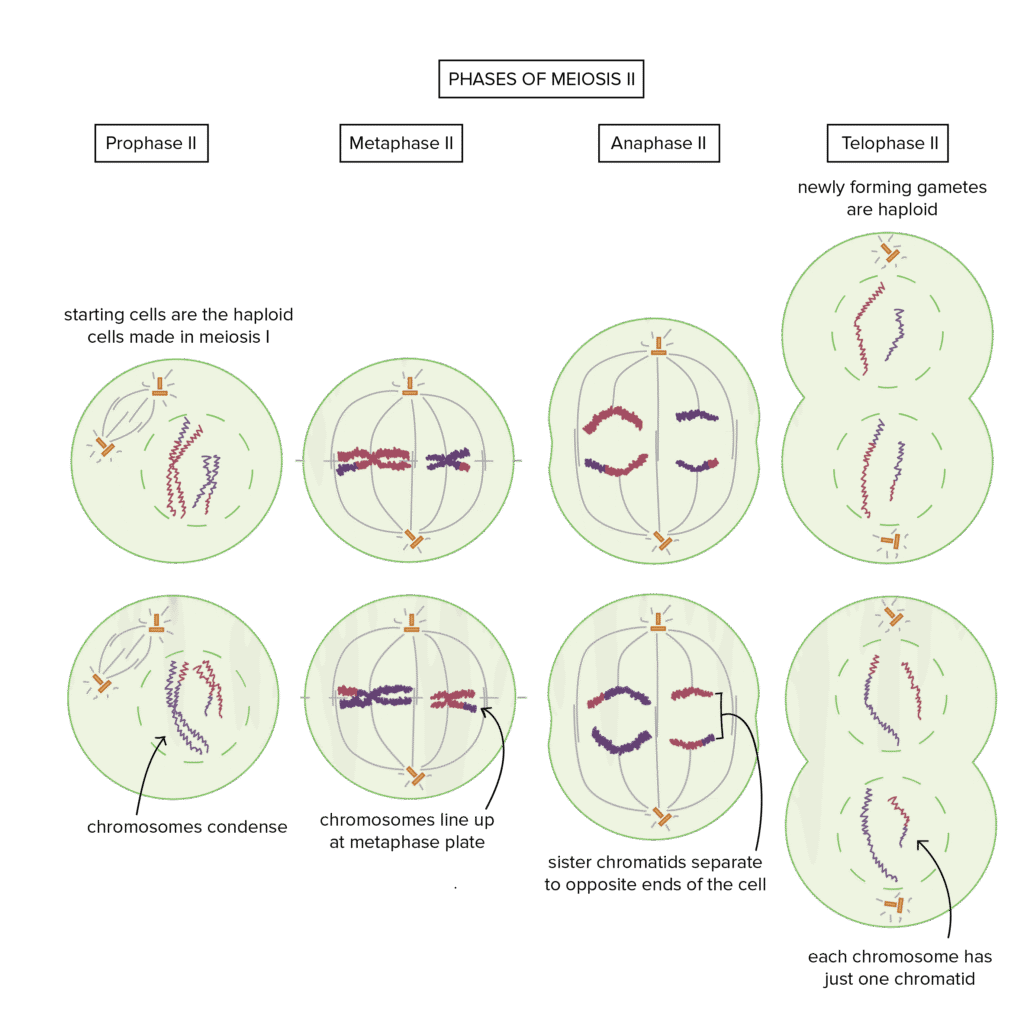
Meiosis: Making Sex Cells
Meiosis is cell division that produces four non-identical daughter cells with half the chromosome number. It’s used for:
- Production of gametes (sex cells) only
- Creating genetic variation
Key points about meiosis:
- Daughter cells are genetically different from parent and from each other
- Daughter cells are haploid (n) – half the chromosomes
- Produces four daughter cells
- Happens in reproductive organs only
- Involves two divisions (Meiosis I and Meiosis II)
Why is meiosis important?
- It halves the chromosome number, so when gametes fuse, the normal number is restored
- It creates genetic variation through:
- Crossing over: Exchange of genetic material between chromosomes
- Independent assortment: Random distribution of chromosomes
Formula:
Parent cell (2n) → Meiosis I → Two cells (n) → Meiosis II → Four gametes (n)Mitosis vs Meiosis Comparison
| Feature | Mitosis | Meiosis |
|---|---|---|
| Purpose | Growth, repair, asexual reproduction | Gamete production |
| Number of divisions | One | Two |
| Number of daughter cells | Two | Four |
| Chromosome number in daughters | Diploid (2n) – same as parent | Haploid (n) – half of parent |
| Genetic identity | Identical to parent | Different from parent |
| Where it occurs | Body cells | Reproductive organs |
| Genetic variation | No | Yes |
Sexual Reproduction in Flowering Plants
Plants have some of the most beautiful and fascinating reproductive strategies in nature. Let’s explore how flowering plants reproduce sexually.
Structure of a Flower
Flowers are the reproductive organs of flowering plants (angiosperms). Here are the main parts:
Male Parts:
- Stamen: The male reproductive organ
- Anther: Produces pollen grains (male gametes)
- Filament: Stalk that supports the anther
Female Parts:
- Carpel (Pistil): The female reproductive organ
- Stigma: Sticky surface that receives pollen
- Style: Connects stigma to ovary
- Ovary: Contains ovules (female gametes)
Other Important Parts:
- Petals: Often colorful; attract pollinators
- Sepals: Protect the flower bud
- Receptacle: Base that supports flower parts
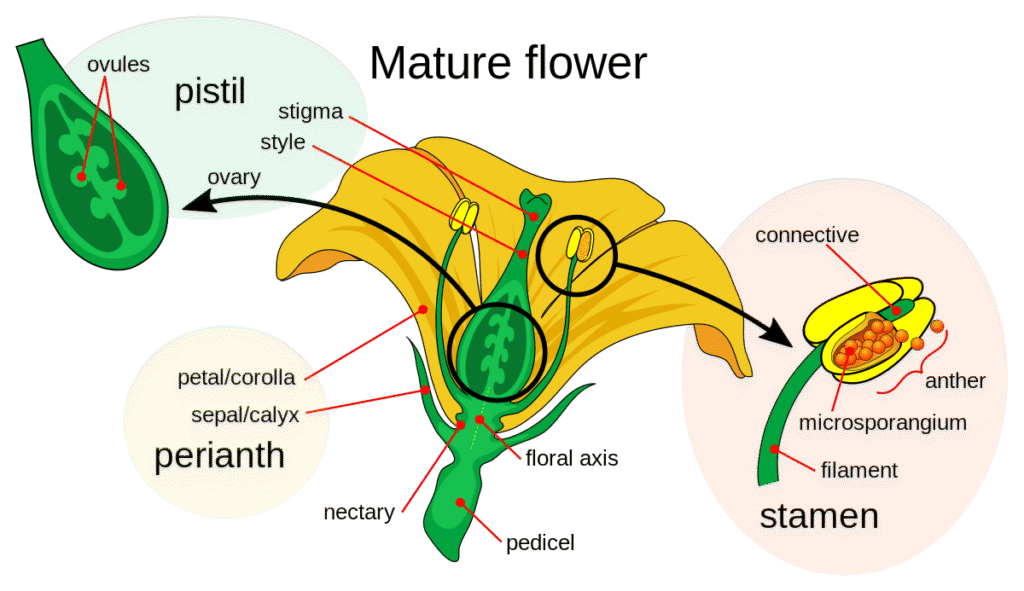
Pollination: Getting Pollen to the Stigma
Pollination is the transfer of pollen grains from the anther to the stigma.
Types of Pollination:
1. Self-pollination: Pollen lands on the stigma of the same flower or another flower on the same plant
- Advantage: Doesn’t require pollinators
- Disadvantage: Less genetic variation
2. Cross-pollination: Pollen transfers from one plant to the stigma of a flower on a different plant
- Advantage: Increases genetic variation
- Disadvantage: Requires pollinators or wind
Methods of Pollination:
Insect Pollination:
Flowers adapted for insect pollination have:
- Brightly colored petals
- Scented to attract insects
- Nectar production
- Large, sticky pollen grains
- Stigma inside flower
Wind Pollination:
Flowers adapted for wind pollination have:
- Small, dull-colored petals (or none)
- No scent or nectar
- Anthers hanging outside flower
- Large quantities of small, light pollen
- Feathery stigma to catch pollen
Fertilization in Flowering Plants
After pollination, fertilization follows these steps:
- Pollen grain lands on stigma
- Pollen tube grows down through the style toward the ovary
- Male nucleus travels down the pollen tube
- Fertilization occurs when male nucleus fuses with female nucleus (egg) in the ovule
- Zygote forms and develops into an embryo
- Ovule becomes a seed (containing embryo and food store)
- Ovary becomes a fruit (protects and disperses seeds)
Formula:
Pollen grain → Pollen tube → Male nucleus + Female nucleus (in ovule) → Zygote → Embryo → Seed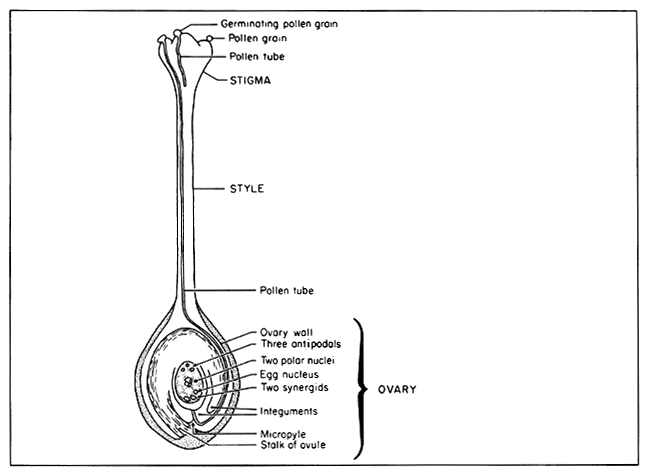
Seed and Fruit Formation
Seed Structure:
- Embryo: Young plant (with radicle and plumule)
- Cotyledons: Food stores for germination
- Seed coat (testa): Protective covering
Fruit: The developed ovary that protects seeds and aids in dispersal
Seed Dispersal
Seeds need to be dispersed away from the parent plant to:
- Reduce competition for light, water, and nutrients
- Colonize new areas
- Avoid overcrowding
Methods of Seed Dispersal:
- Wind: Light seeds with wings or parachutes (e.g., dandelion, maple)
- Animals: Hooked seeds stick to fur, or edible fruits are eaten and seeds excreted (e.g., burrs, berries)
- Water: Buoyant seeds float on water (e.g., coconut)
- Explosive mechanism: Pods burst open, scattering seeds (e.g., peas)
Sexual Reproduction in Humans
Now let’s explore one of the topics students find most interesting (and sometimes awkward!) – human reproduction.
Male Reproductive System
Main Organs and Functions:
1. Testes (singular: testis)
- Produce sperm (male gametes)
- Produce testosterone (male sex hormone)
- Located in the scrotum (outside body cavity to maintain lower temperature for sperm production)
2. Scrotum
- Sac of skin that holds testes
- Regulates temperature for sperm production
3. Sperm Ducts (Vas Deferens)
- Tubes that carry sperm from testes to urethra
4. Prostate Gland and Seminal Vesicles
- Produce seminal fluid
- Provides nutrients for sperm
- Together, sperm + seminal fluid = semen
5. Urethra
- Tube that carries semen out of the body through the penis
6. Penis
- Transfers sperm into female reproductive system
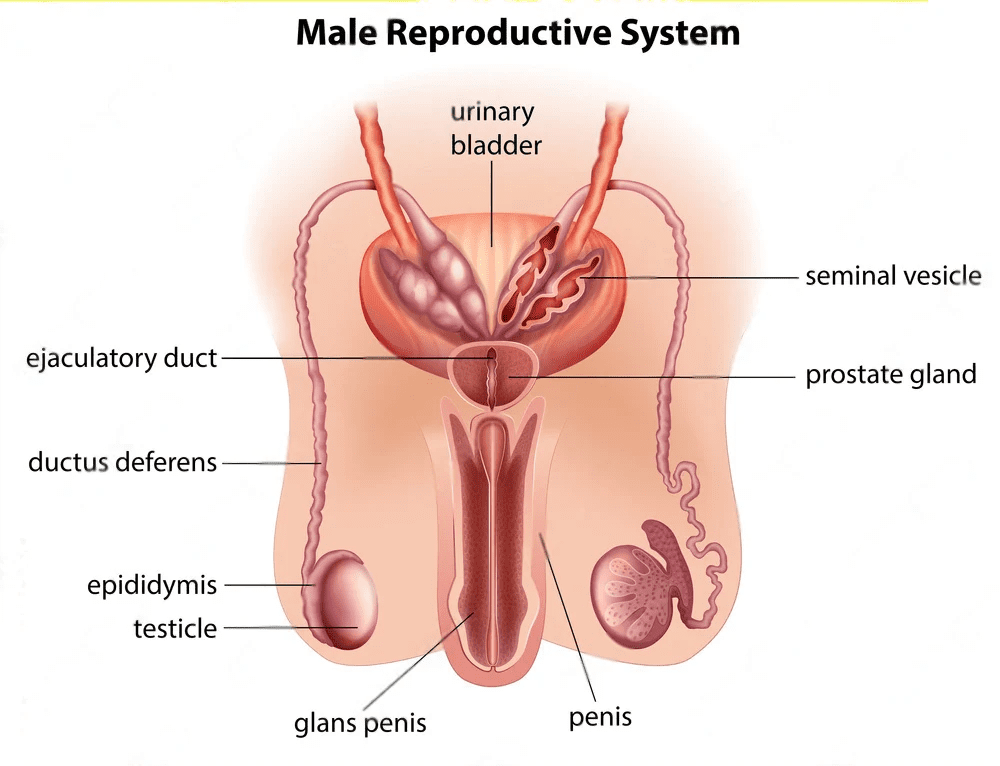
Sperm Structure:
- Head: Contains nucleus with genetic material; acrosome with enzymes to penetrate egg
- Middle piece: Packed with mitochondria for energy
- Tail (flagellum): For swimming toward egg
Adaptations of sperm for fertilization:
- Streamlined shape for swimming
- Tail for movement
- Many mitochondria for energy
- Enzymes in head to digest egg membrane
Female Reproductive System
Main Organs and Functions:
1. Ovaries
- Produce eggs (ova/female gametes)
- Produce female sex hormones (estrogen and progesterone)
- Usually release one egg per month (ovulation)
2. Oviducts (Fallopian Tubes)
- Tubes that carry eggs from ovaries to uterus
- Site of fertilization
- Lined with ciliated cells to move egg along
3. Uterus (Womb)
- Muscular organ where fetus develops
- Lining (endometrium) thickens each month to prepare for pregnancy
4. Cervix
- Narrow opening at the base of uterus
- Produces mucus
5. Vagina
- Muscular tube
- Receives penis during sexual intercourse
- Birth canal during childbirth
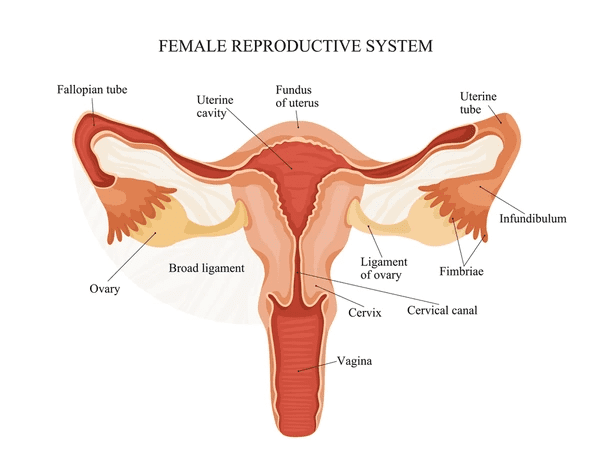
Egg (Ovum) Structure:
- Much larger than sperm
- Contains nucleus with genetic material
- Cytoplasm with food reserves
- Jelly-like coating
Adaptations of egg for fertilization:
- Large food store for early development
- Protective jelly coat
- Chemical signals to attract sperm
The Menstrual Cycle
The menstrual cycle is a monthly cycle that prepares the female body for pregnancy. It typically lasts about 28 days (though this varies between individuals).
Key Events:
Days 1-5: Menstruation (Period)
- Uterus lining breaks down and is shed
- Bleeding occurs
Days 6-13: Repair and Build-up
- Uterus lining repairs and thickens
- Estrogen levels increase
- Follicle in ovary matures
Day 14: Ovulation
- Mature egg is released from ovary
- Egg travels down oviduct
- Most fertile time
Days 15-28: Maintenance
- Uterus lining maintained
- Progesterone levels high
- If fertilization doesn’t occur, cycle repeats
If fertilization occurs:
- Embryo implants in uterus lining
- Menstruation does not occur
- Pregnancy begins
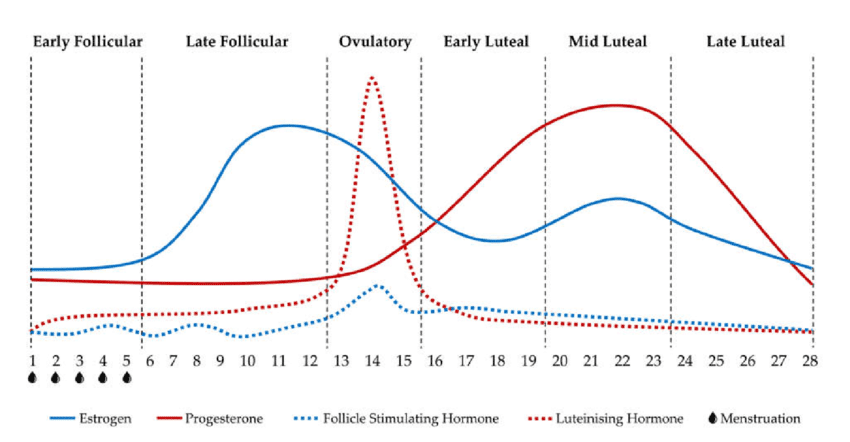
Hormones Involved:
- FSH (Follicle Stimulating Hormone): Causes egg to mature in ovary
- Estrogen: Causes uterus lining to thicken; triggers LH release
- LH (Luteinizing Hormone): Triggers ovulation
- Progesterone: Maintains uterus lining
Fertilization and Pregnancy
Fertilization Process:
- Sexual intercourse: Sperm deposited in vagina
- Sperm swim through cervix and uterus into oviducts
- Fertilization occurs in the oviduct when one sperm penetrates the egg
- Zygote forms (fertilized egg with 46 chromosomes)
- Cell division begins as zygote travels down oviduct
- Implantation: Embryo embeds in uterus lining (about 7 days after fertilization)
Formula:
Sperm (23 chromosomes) + Egg (23 chromosomes) → Zygote (46 chromosomes) → Embryo → Fetus → BabyPregnancy Development:
- Weeks 1-8: Called an embryo; major organs begin to form
- Week 9 onwards: Called a fetus; organs continue to develop
- Full term: About 40 weeks (9 months)
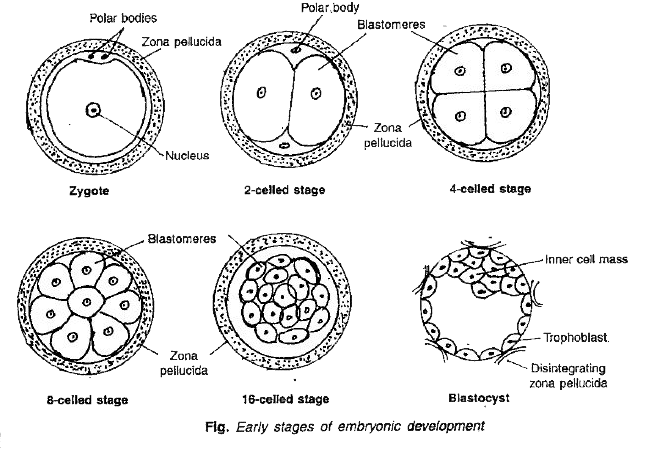
The Placenta and Fetal Development
Placenta: A special organ that develops during pregnancy
Functions of the Placenta:
- Allows transfer of nutrients and oxygen from mother’s blood to fetus
- Allows transfer of waste products (CO₂, urea) from fetus to mother
- Produces hormones to maintain pregnancy
- Acts as a barrier to some harmful substances
Important: Mother’s and fetus’s blood DO NOT MIX – substances are exchanged by diffusion across the placenta
Other Structures:
- Umbilical cord: Connects fetus to placenta; contains blood vessels
- Amniotic fluid: Liquid surrounding fetus; protects from bumps and temperature changes
- Amniotic sac (amnion): Membrane that holds amniotic fluid
Methods of Birth Control (Contraception)
Contraception refers to methods used to prevent pregnancy. Here are the main types:
1. Barrier Methods
- Condoms: Prevent sperm from entering vagina; also protect against STIs
- Diaphragm: Covers cervix to prevent sperm entry
2. Chemical Methods
- Contraceptive pill: Contains hormones that prevent ovulation
- Spermicides: Chemicals that kill sperm
3. Intrauterine Devices (IUDs)
- Small device inserted into uterus
- Prevents implantation
4. Natural Methods
- Rhythm method: Avoiding intercourse during fertile period
- Less reliable than other methods
5. Surgical Methods
- Vasectomy (male): Sperm ducts cut
- Tubal ligation (female): Oviducts cut
- Permanent methods
6. Abstinence
- Not having sexual intercourse
- 100% effective against pregnancy and STIs
Quick Revision Notes
Asexual vs Sexual Reproduction
- Asexual: One parent, identical offspring, no gametes, fast
- Sexual: Two parents, varied offspring, gametes fuse, slower
Mitosis vs Meiosis
- Mitosis: Growth and repair, 2 identical diploid cells
- Meiosis: Gamete production, 4 different haploid cells
Flower Parts
- Male: Stamen (anther + filament) produces pollen
- Female: Carpel (stigma + style + ovary) contains ovules
Pollination Types
- Insect-pollinated: Colorful, scented, sticky pollen, nectar
- Wind-pollinated: Dull, no scent, light pollen, feathery stigma
Human Reproduction
- Male: Testes produce sperm in scrotum
- Female: Ovaries produce eggs; fertilization in oviduct
- Menstrual cycle: ~28 days; ovulation around day 14
- Placenta: Exchanges materials but blood doesn’t mix
Key Formulas and Equations Box
1. Fertilization:
Male gamete (n) + Female gamete (n) → Zygote (2n)
2. Human gametes:
Sperm (23) + Egg (23) → Zygote (46 chromosomes)
3. Mitosis:
Parent cell (2n) → 2 identical daughter cells (2n)
4. Meiosis:
Parent cell (2n) → 4 different daughter cells (n)
5. Plant reproduction:
Pollination → Fertilization → Ovule becomes seed → Ovary becomes fruit
6. Pregnancy timeline:
Fertilization → Zygote → Embryo (weeks 1-8) → Fetus (week 9+) → Birth (~40 weeks)Common Mistakes to Avoid
Confusing mitosis with meiosis
- Remember: Mitosis = Making identical cells for growth
- Meiosis = Making sex cells with half the chromosomes
Thinking mother’s and baby’s blood mix in the placenta
- They don’t! Substances are exchanged by diffusion
Mixing up pollination and fertilization
- Pollination = pollen reaches stigma
- Fertilization = male and female nuclei fuse
Saying gametes are diploid
- Gametes are ALWAYS haploid (n), not diploid (2n)
Confusing ovulation with menstruation
- Ovulation = egg release (around day 14)
- Menstruation = period/bleeding (days 1-5)
Forgetting that asexual reproduction creates clones
- All offspring are genetically identical in asexual reproduction
Conclusion: You’ve Got This!
Congratulations! You’ve just worked through one of the most comprehensive and important topics in IGCSE Biology. Reproduction is absolutely fundamental to understanding how life continues, how organisms are similar to yet different from their parents, and how species adapt and evolve over time.
Remember, this topic connects to so many other areas of biology:
- Genetics: Understanding how characteristics are inherited
- Evolution: How variation leads to natural selection
- Ecology: How populations grow and organisms colonize new areas
- Cell biology: Understanding cell division and specialization
Final Motivational Thought:
Biology is the study of life, and reproduction is literally the continuation of life. You’re not just learning facts for an exam – you’re understanding the fundamental processes that made you who you are and that ensure life continues on our amazing planet. Every organism alive today is the result of billions of years of successful reproduction, passed down from generation to generation. How incredible is that?
Keep practicing, stay curious, and remember – you’ve got everything you need to ace this topic. Good luck with your studies, and may your IGCSE Biology exam be a huge success!
Recommended –

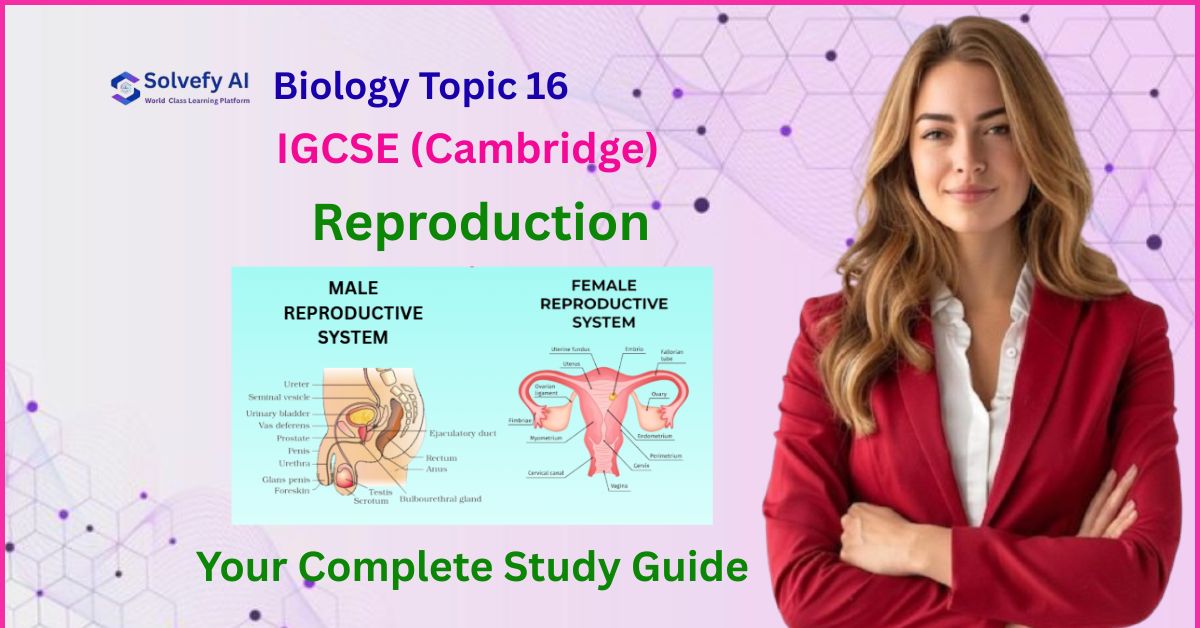
1 thought on “Reproduction | IGCSE Biology Topic 16 Complete Guide”